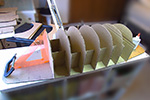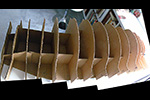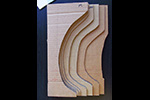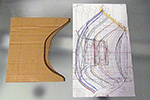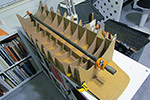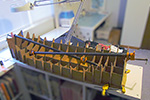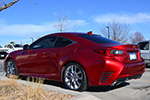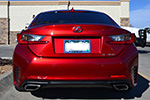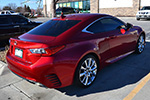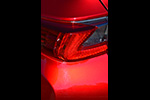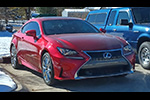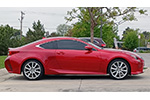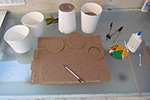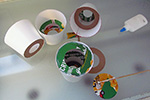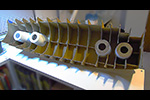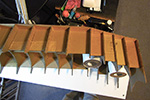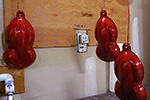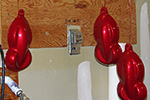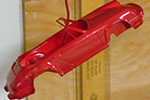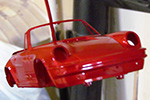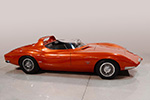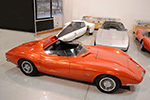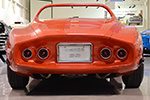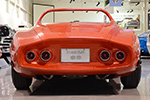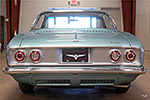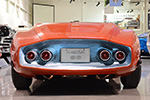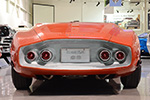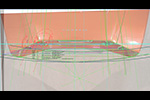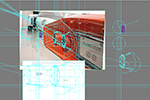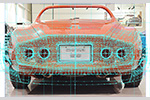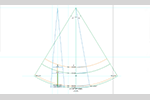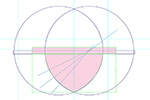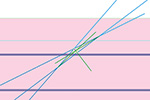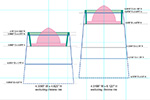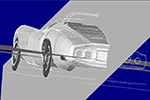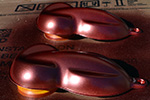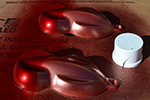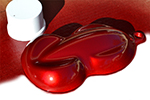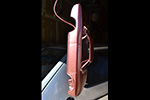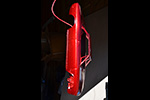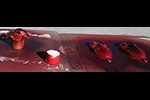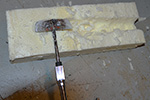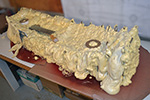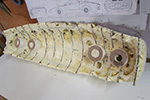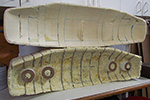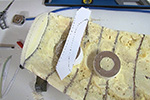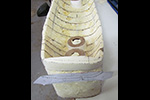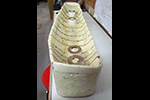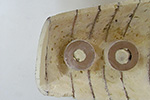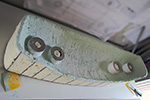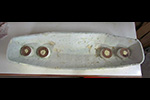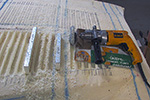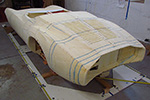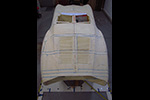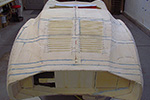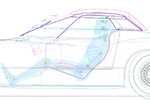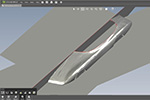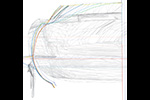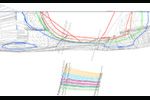
Contact: Rich Kurz Page content last updated March 30, 2024
The Construction Diary
2024
JANUARY
Did I say a third try making the Kamm cove?!?! I DID!
So, while making the cardboard contour template to fit inside the Kamm cove foam piece, I realized that I was also making the contours to create another Kamm cove.
Only this one would be more accurate, having more contours.
To then create a finished piece, I could spray insulation foam between the contours and sand down to shape.
And it would begin from the accurate cutout of the Kamm cove outline, which when all is done, I could then simply insert into the tail of the foam body.
This struck me as a more accurate, easier to be accurate, and easier to mate with the foam body approach.
It was well worth trying at this point.
So I glued the cove contours onto the Kamm outline cutout.
That done, the next step is to make the taillight cones to glue down on the Kamm outline.
I laid those out, having plotted my cone shape from my 3D drawings, and laid out the shape on some thick, glossy card sheet.
I made it long enough to wrap it twice around. Then I cut out three diameters to glue inside the rolled up shape at the top, middle, and base.
That done, I cut out the placement positions from the contours and inserted the cones, and stood back and studied what I made.
It did not look right. The outer cone look too tall and too narrow at top, while the inner cone looked too short and too wide at the top.
Back to my drawings and refining my 3D points and using my photos of the car to derive the shapes, heights, and placements.
Slowly, painfully slowly, I am settling on final dimensions for the taillights.
It is frustrating and I have to admit that I am stuck in this muck.
But I must come to conclusions I can live with.
SIDEBAR: In Search of the Lost Color
When I saw the original car in 2016, I was struck and intrigued by the paint job on it.
The car from certain angles glowed!
It was more orangey than I expected, too.
So I wondered, 'what WAS the original color? Surely what it is now was not it!'
I could say that because I read notes in the GMHC library saying it was repainted at least once after the rollbar was attached.
And the underside shows definite overspray matching the current color.
Thus began a Quixotic "Impossible Dream" of matching what was no longer.
There are a number of color photos in the GMHC collection that show the pre-rollbar car.
One could match the color in the photos, but you must realize that even with a color card, photo pigments are not the same as paint pigments.
But it did look like the photos showed a color redder - less orangey - than the current paint job.
I thought my best bet was to contact former designers who might remember the car as it first appeared.
There are not many, but they were gracious to me to provide some recollections.
It's a good idea, but subject to possible fading memory and personal preferences.
Of course, they are practiced, experienced professionals and experts in this matter.
One it wise to give their opinion weight.
Mostly, they could tell me what modern colors it was NOT!
But one even sent me a custom painted item with his best guess at the color.
It is good enough that, in my opinion, it is the closest match so far.
Another approach was to locate cars with the same custom GM paint job still on them and get a color reading.
I found a photo of both the Monza SS and a special Corvette made for the 1964-65 New York Worlds Fair.
In the photo, they looked very close in color!
The Corvette today is at the Pierce-Arrow museum in Buffalo.
With their permission, I arranged a color reading with the local PPG supplier.
The spectroscope only identifies the closest color from the PPG library of over 2000 colors.
It resulted in a close comparison, but not exact, as can be seen here.
I compared a chip with the current Monza SS on my 2nd visit, but it did not match even closely.
I started desparing, and decided to just find something that struck my idea of the color.
Jump forward a couple of years, and I was put on to one possible modern color that seemed close according to those retired designers.
It was not Mazda Soul Red Crystal 46V, but Lexus Infrared Metallic 3T5, a 3- (or maybe 4) stage finish.
And lo, and behold! a Lexus SC 350 showed up regularly at a nearby car parts store.
I would be able to meet its owner, study it and compare paint samples to it.
So next I begin to learn about how custom paint jobs are done and by doing them.
How DOES one do a candy or a tri-color, or a pearlescent or an irridescendent??
FEBRUARY
Back I went to my drawings and my photos.
I found three photos that approximated orthographic rear, top, and side views.
I attempted to determine the vanishing lines to establish the correct position in perspective for features of interest.
I then compared what I got from the drawings (making tracings) to the Photomodeler drawings.
Vanishing lines were hard to work out. I tried to find measureing points in the same planes of interest.
After comparing the tracings to the Photomodeler master drawing, I decided that the Photomodeler drawing was the most reliable drawing to work with.
Still, I adjusted its dimensions for the taillight cones to the nearest 1/8 inch, and the differences looked to be minor or not observable.
So, once again, I created patterns to make the taillight housings.
They will be very close to my first set, but more trustworthy.
MARCH
With the contours glued down to the backing board and the tailcones placed, it is time to fill it in with the spray insulation foam, large-gap formula.
It is not as controlled coming out as I expected. Controlling the amount was difficult and not exact.
I ended up spraying down too much, which resulted in air pockets under the surface when I came back over an area.
And, the large-gap foam cannot be easily built up. It comes out too much and therefore too heavy to hold itself up.
So I needed three sessions to get enough to mostly cover the contours.
And each session needed 2 to 4 days to cure.
And even then, when I sanded into an air pocket, I found uncured areas that did not have enough air exposure.
Carving began by using a hand saw to trim the excess off the outside and the inside.
Then I discovered my large-grit, 40-grit sanding disc did a nice job of quickly sanding it down and leaving a smooth surface.
But angling it, I could reach most areas. I used a Dremel with a wire brush to clean off the cones without damaging them.
I needed to add more foam, this time with regular formula spray foam, to fill the air pockets I uncovered, and to build up the outside edge.
Two rounds later, I had a decent-looking Kamm cove foam form.
The last step was to do the ends. I cut off enough foam to glue on a block of foam on each end.
I then used a template to mark the outline as seen from the back, and then the outline as seen from the side.
That quickly shaped it into completion.
Finally, it was time to surface it with Bondo.
This was not a easy as I imagined.
First lesson - don't use a metal putty knife. One, Bondo sticks to it like, well, like to metal.
Two - the knife is not flexible enough for a complex curving surface such as the cove.
Second lesson - Bondo dries HARD! It is very time-consuming to sand by hand and sanding block.
I switched to a 40-grit sanding pad that was not as aggressive as what I used on the foam.
This, too, could be angled to reach nearly all of the cove.
But it had to be held securely to run it along a surface.
Meanwhile, while things were drying, I turned to the engine vents.
My first idea was too aggressive for the foam and too hard to control.
My second idea took a scuffing disc and shape it to the contour of the vent cross-section.
Then, to push or pull it thru the foam, I mounted the hand drill on a cardboard cradle.
I then pushed the scuffing disc along my marked lines.
One thing I had to do was cut and pull out the blue glue pieces.
While I was at it, I also cut along the marked lines hopefully to give a clean line when done.
Removing the glue saved the contour shape of the scuffing disc from being worn down by the rubbery glue.
APRIL
While all the above was happening, on the side I prepared drawings showing contours thru the windscreen and side glass around the cabin.
My thought is to closely follow the shape of the windscreen and extend it upward as a complete windshield.
The side close I hope to do the same and make it so it can crank up and down.
The difficulty is the changing rake of the windscreen as it flows from the front crease around to the doors and back to the rear deck.
The angle changes relative to the horizontal plane from almost 30 degrees at the front windscreen crease to nearly 50 degrees at the rear deck for the side glass.
Most of the change occurs where the windscreen bends around to the door front cut, and is nearly constant on either side of that bend.
Just this quarter I discovered a program to allow me to create cuts thru my surfaced 3D Monza SS file.
It is a freeware viewer from Solidworks called eDrawings.
I created several cuts of the cabin area from the front view and the side view and the top view.
I could then test what I would get if I extend the glass higher to where a top would be.
It looks good to do so, maintaining the same shape wraparound windscreen as the original car.
To have the side windows roll up and down requires a constant (unchanging) curvature side to side and up to down to be able to keep fitting the opening slit in the door for the glass.
If I can keep the same shape for the front windscreen, then I might be able to make it so I can swap out the taller windshield for the 5-inch high windscreen like on the original car.
That way I can have it both ways.
When shaping the windshield/side glass/top, I will duplicate the outlines on my chassis to confirm the final actual dimensions of this critical piece.
And if successful, I will had a removeable top that will stow up front.
Otherwise, I will have to go with the heavier fold-up convertible top with all the complication of stowage behind the seats and the extra weight.
Check back for more progress!
SIDEBAR: In Search of the Lost Color
When I saw the original car in 2016, I was struck and intrigued by the paint job on it. The car from certain angles glowed! It was more orangey than I expected, too. So I wondered, 'what WAS the original color? Surely what it is now was not it!' I could say that because I read notes in the GMHC library saying it was repainted at least once after the rollbar was attached. And the underside shows definite overspray matching the current color. Thus began a Quixotic "Impossible Dream" of matching what was no longer.There are a number of color photos in the GMHC collection that show the pre-rollbar car. One could match the color in the photos, but you must realize that even with a color card, photo pigments are not the same as paint pigments. But it did look like the photos showed a color redder - less orangey - than the current paint job.
I thought my best bet was to contact former designers who might remember the car as it first appeared. There are not many, but they were gracious to me to provide some recollections. It's a good idea, but subject to possible fading memory and personal preferences. Of course, they are practiced, experienced professionals and experts in this matter. One it wise to give their opinion weight. Mostly, they could tell me what modern colors it was NOT! But one even sent me a custom painted item with his best guess at the color. It is good enough that, in my opinion, it is the closest match so far.
Another approach was to locate cars with the same custom GM paint job still on them and get a color reading. I found a photo of both the Monza SS and a special Corvette made for the 1964-65 New York Worlds Fair. In the photo, they looked very close in color! The Corvette today is at the Pierce-Arrow museum in Buffalo. With their permission, I arranged a color reading with the local PPG supplier. The spectroscope only identifies the closest color from the PPG library of over 2000 colors. It resulted in a close comparison, but not exact, as can be seen here. I compared a chip with the current Monza SS on my 2nd visit, but it did not match even closely.
I started desparing, and decided to just find something that struck my idea of the color. Jump forward a couple of years, and I was put on to one possible modern color that seemed close according to those retired designers. It was not Mazda Soul Red Crystal 46V, but Lexus Infrared Metallic 3T5, a 3- (or maybe 4) stage finish. And lo, and behold! a Lexus SC 350 showed up regularly at a nearby car parts store. I would be able to meet its owner, study it and compare paint samples to it.
So next I begin to learn about how custom paint jobs are done and by doing them. How DOES one do a candy or a tri-color, or a pearlescent or an irridescendent??
The Build--2023
January
1st ROW - Male Contour Form
(L) Making the positive (male) contour form.
(R) The completed form.
2nd ROW - Female Contour Form
(L) Looking at the remaining contour halves, I realized I could (SHOULD) make a negative (female) form, which would be the actual surface!
(CL) Looking at how I made my drawings, I realized I needed to trim some more off of those on the canted-out wings. The idea is to build up the space between the contours with spray-on insulation foam and sand down to the forms to shape. The cardboard pieces show the difference. The drawing was my corrections.
(CR) Here is the form nearly all built up.
(R) And setting the final contours.
3rd ROW - The Closest Color???
(L) One of my designer friends recommended a color on the Lexus, 3T5 Infrared.
(CL) To my relief and delight, an SC 350 turned up at a local car parts store.
(CR) I would see it there from time to time and got to talk with its owner.
(R) This is what it looks like in the blue-sky sunlight.
4th ROW
(L) And this is what is looked like in bright sunlight one morning.
R And this is what it looks like under an overcast sky. Note the differentshades between the fenders and the door.
5th ROW - Building the Taillight Cones
(L) I laid out my cone pattern using basic drafting techniques, and cut out circular bulkheads for the top, middle, and bottom of each cone.
(CL) The bulkheads have a hole in each so I can reach down thru it when glueing and foaming.
(CR) And then I cut out space to insert the cones into the contour form.
(R) Top view. After studying it, I was uncomfortable with their size and heights and positions. Time to go back to my drawings, before I go any further.
6th ROW - Test Paint Barcelona Red Micah
(L) The weather turned warm and I ordered what I had orignally been told was the Lexus color: 3R3 Barcelona Red Micah. Here are my speed forms under regular indoor lighting.
(CL) And here they are taken with a flash - a whiter light and with stronger highlights.
(CR) I tried it on a model Porsche kit as well.
(R) It looks as different in the photos as it does in real life. The speed shapes have three good coats of a single stage paint, while the model has only two. Both are on top of white plastic. And finally, there is a 2K clear topcoat for a shiny, smooth, hard gloss.
7th ROW - Visualizing Changes
(L) These first two photos are to visualize what the car would look like with a flush gas cap cover, instead of a flip-up LeMans cap. I have not been able to find one the right size, that I deduce to be about 3-1/2" diameter. I either find a 5" version or a 2-1/2" version, both of which look out of proportion.
(CL) I have made a circle, much like on the Aerovette, where the cas filler cover would be in place of the LeMans cap.
AND. . . I also deleted the fender mirrors and replaced the funky exhaust pipe with the straight pipe from the original release in April 1963.
(CR) Here is a before and after version of the rear license. I have always been bothered by the rear plate mount. It is beautifully sculpted into the Kamm cove, but it looks too big - especially too tall.
(R) My thought is to make a bracket that grips the plate on the sides, with a built in light, and mount the bracket to the cove at a single mounting point. The plate would, in effect, float above the cove. This, and the use of the original headlight covers, would be the only departures from the reproduction.
8th ROW - Visualizing Kamm Cove
(L) As an inspiration, I took the brushed aluminum-looking tail panel on the 1965-69 Corvairs and tried that out on the deeply dished Monza SS cove - quite unlike the flat version on the Corvairs.
(C) I tried something not quite chrome, but more polished than brushed metal as was on the Corvairs.
(R) The feedback I received about the near-chrome cove was that it was too showey. Argent paint was suggested instead. Here's how that might look.
February
1st ROW - Back to the Drawing Board
(L) I pulled up three good views, as close to orthographic as I could find. This top-down view should give me a good measure of the taillight widths and positions.
(CL) This near, side view gives me the best idea of the height, or projection, of the taillight from the cove.
(CR) This straight-on view will be matched to what I derived from Photomodeler. In the end, I gave greatest weight to the PHotomodeler drawings, and just made adjustments to sizes and positions.
(R) And here is the layout for the inside (green arc) and outside (orange arc) taillights, based on a cone angle of 10 degrees (5 degrees from vertical each side as seen from a side view). Then a simple drafting layout solution is done. The circumference ("1 rev") is doubled to make a doubled wrap cone shape from the pattern, a 31 degree slice of the total cone circle.
2nd ROW - The Final Set???
(L) I even discovered my taillight lens drawing was incorrect. So I decided to also correct the bullet profile at the same time, making it a circular arc instead of hand-drawn. The pink area is the rescaled old lens drawing before correcting the curvature.
(CL) Using the handdrawn curve, I found the midpoint of the hypothetical curve radius. Actually, my three perpedicular radii did not go to the same intersection point, so I needed to do a contructed average. And that worked very well!
(CR) Only THEN . . . could I create my final drawing. I created these sections to also place the lenses, the chrome trim rings on the end, and the placement and diameters of reinforcement bulkheads (bold black lines.)
(R) After all the work last summer surfacing the 3D model, I established some XYZ planes and oriented it to the model. Wow! it looks good from this angle!
March
1st ROW - 3T5 Paint Test
(L) Speed shapes with base color.
(CL) The same with a single coat of midcoat on one-third of the shapes.
(CR) Speed shape completely covered with one coat.
(R) Base coat on a 1/25 Corvair model. This gives a better idea of the metallic color and reflectance.
2nd ROW
(L) Corvair body with one coat of midcoat color. The clearcoat did not change it any.
(CL) Second test of 3T5 to see if I could lay down a lighter midcoat. The cap shows the midcoat color on a white ground color. The Beetle on the left was my best attempt at a light coat. It looked dull until I applied the clearcoat.
(CR) Meanwhile I fabbed a gouging blade for the handdrill to cut hood vents. It was too course and uneven when cutting thru foam.
(R) Paint and drill bit happened while the spray insulation foam was setting in the Kamm cove form. It was hard to build it up on the rim. It looks pretty ugly at this point!
3rd ROW - Carving the Cove
(L) After trimming with a blade the excess on the outside, came the samding with a 40grit disc on the handdrill and using my small handrasps to carve out the cove.
(CL) There were lots of cavities where the foam did not expand into. I applied a 2nd layer too quickly so that the 1st layer was not exposed to air and could not cure well. This compares the first trial cove above with the second trial cove. The sheet foam is nicer to work with than the sprayfoam, but the contours make it more accurate to carve.
(CR) The final step in carving was shaping the ends. I glued a block on each end, traced my outline from the end view, then the side view, and sanded to shape.
(R) The side view and my tracing pattern.
4th ROW - 1st Bondo
(L) The ends, trimmed to shape.
(CL) A view looking into the cove from behind.
(CR) The first coat of Bondo.
(R) Hand sanding would take hours. I used a coarse disc meant for metal and got most of it sanded down.
5th ROW - Rear Deck Hood Vents
(L) My 2nd attempt to carve the rear-deck hood vents. I shaped a scuffing disc to the vent contour, made a sliding holder for the drill, and slowly, carefully ran it along lines drawn on the foam. Note the protruding pieces in the vents to reinforce the material inbetween the vents holes.
(CL) The final result.
(CR) The first three or four vents will need some fixing, and on a place or two the disc grabbed and went past the ending lines. All will be corrected at surface-hardening.
(R) The blue joints had to be cut with a matte knife and the blue glue dug out, or else it would have destroyed the shape of the disc.
April
1st ROW - Getting Ready for Glass and Top
(L) How small can I make a removeable top? Somewhere between the purple and the magenta versions. The figure represents my expected seated position.
(CL) The 3D surface model in eDrawing showing a cut in red thru the windscreen passing thru the front base.
(CR) Front view of combined cuts showing how side window curvature changes from front to back.
(R) Top view showing cuts thru windscreen and side glass. The bottom drawing shows how the curvature changes from bottom to top. The green line represents the orthgraphic top view shape of the glass curvature at the level of the door window slit.
